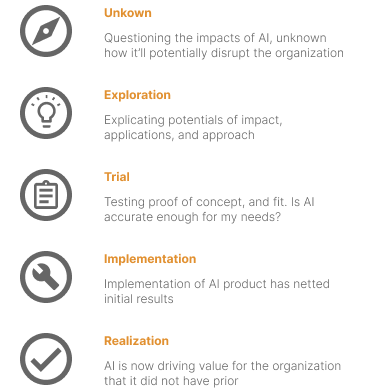Businesses of all sizes
Enhancing AI adoption strategy for businesses
We help businesses, specifically small and medium sized ones navigate the complexities of AI adoption.
Industry
General
Services
Digital Transformation and Innovation
Modernization
Business Transformation
Technology Solutions
Methods and deliverables
Discovery Research
Project Partner Interviews
Workshops
Digital Best Practices
Technical analysis
The importance of the right Approach
Artificial intelligence and machine learning offer the potential to enhance long-term business productivity optimization strategies and promote increased efficiency. However, like many employers, there is a noticeable shortage of skills required to facilitate widespread AI adoption across diverse business verticals and sectors of the economy.
It’s also true that artificial intelligence has become a pivotal catalyst for business and economic expansion globally. It empowers organizations to enhance their offerings, operate with greater efficiency and effectiveness, and address significant industry challenges that may have otherwise remained unresolved.
Amid the rush of businesses to integrate AI for productivity gains, it’s crucial to pause and engage in strategic planning. Identifying areas within the business where AI could leverage unique datasets to yield the greatest impact is essential. The adoption of AI technologies holds the potential to offer businesses unparalleled acceleration and valuable insights if done right.
Considerations
Although AI offers a promising avenue for unlocking business potential and efficiencies, organizations must also focus on areas of impact while nurturing competencies in AI to realize these improvements effectively. We’ve compiled some questions to consider if your organization is exploring AI technologies.
- How unique is the data? and does it change the competitive landscape if it’s in the public domain.
- AI tech can provide significant automation, how should you provide maximize people’s potential?
- Have you planned out where your organization would like to first use AI? HR? Projections? Automation?
- Do you have the correct internal team to build a technology adoption plan?
- Have you reimagined the transformation for your organization?

Two Main Questions
For organizations pondering their starting point, we strongly recommend delving into the following two questions:

The exercise of pondering these two questions serves as a call to action:
For “Largest Impact,” businesses are encouraged to conduct a comprehensive assessment of their operations to pinpoint areas where AI implementation could yield significant enhancements. Identifying these key areas allows for the development of a strategic action plan to navigate from point A to point B.
As for “Immediate Impact,” the focus is on identifying low-hanging fruit—opportunities where AI adoption can be swiftly implemented to demonstrate tangible benefits. This approach enables businesses to quickly test the waters and observe the impact of AI integration.
It’s crucial to recognize that AI might not be confined to one major system (ie. customer facing application); rather, it comprises a multitude of individual systems and new processes operating in tandem. For instance, a business might deploy AI in its HR department for tasks like hiring assistance, shift scheduling, and performance reviews. Meanwhile, the finance team could leverage AI for forecasting, cost analysis, and capital allocation. Similarly, the operations team might utilize AI for inventory control, among other functions. This multifaceted approach unlocks new potentials for businesses across various domains.
The Path Forward: Navigating AI Adoption with Strategy
As businesses explore the opportunities AI presents, it’s essential to view AI not just as a single, overarching solution but as a tool that can be strategically implemented across multiple departments to drive efficiencies and innovation. From HR to finance to operations, each department can harness AI to tackle specific challenges, streamline processes, and enhance decision-making.
By focusing on both the largest impact and immediate impact areas, organizations can build a roadmap for AI adoption that is both ambitious and achievable. This balanced approach allows businesses to reap early benefits while laying the groundwork for long-term transformation.
Ultimately, AI adoption is an ongoing journey—one that requires continuous learning, testing, and refining. As technology evolves, so will the opportunities it presents. For companies willing to embrace this shift, the rewards are immense: greater efficiency, smarter decision-making, and the ability to stay ahead in an increasingly competitive landscape.
Are you ready to start your AI journey? The time to act is now.

